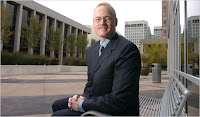Obvious benefits come to mind. Parents can take advantage of the Global Positioning System chips embedded in many cellphones to track the whereabouts of their phone-toting children.
And for teenagers and 20-somethings, who are fond of sharing their comings and goings on the Internet, youth-oriented services like Loopt and Buddy Beacon are a natural next step.
Sam Altman, the 22-year-old co-founder of Loopt, said he came up with the idea in early 2005 when he walked out of a lecture hall at Stanford.
“Two hundred students all pulled out their cellphones, called someone and said, ‘Where are you?’ ” he said. “People want to connect.”
But such services point to a new truth of modern life: If G.P.S. made it harder to get lost, new cellphone services are now making it harder to hide.
“There are massive changes going on in society, particularly among young people who feel comfortable sharing information in a digital society,” said Kevin Bankston, a staff lawyer at the Electronic Frontier Foundation based in San Francisco.
“We seem to be getting into a period where people are closely watching each other,” he said. “There are privacy risks we haven’t begun to grapple with.”
But the practical applications outweigh the worries for some converts.
Kyna Fong, a 24-year-old Stanford graduate student, uses Loopt, offered by Sprint Nextel. For $2.99 a month, she can see the location of friends who also have the service, represented by dots on a map on her phone, with labels identifying their names. They can also see where she is.
One night last summer she noticed on Loopt that friends she was meeting for dinner were 40 miles away, and would be late. Instead of waiting, Ms. Fong arranged her schedule to arrive when they did. “People don’t have to ask ‘Where are you?’” she said.
Ms. Fong can control whom she shares the service with, and if at any point she wants privacy, Ms. Fong can block access. Some people are not invited to join — like her mother.
“I don’t know if I’d want my mom knowing where I was all the time,” she said.
Some situations are not so clear-cut. What if a spouse wants some time alone and turns off the service? Why on earth, their better half may ask, are they doing that?
What if a boss asks an employee to use the service?
So far, the market for social-mapping is nascent — users number in the hundreds of thousands, industry experts estimate.
But almost 55 percent of all mobile phones sold today in the United States have the technology that makes such friend-and- family-tracking services possible, according to Current Analysis, which follows trends in technology.
So far, it is most popular, industry executives say, among the college set.
But others have found different uses. Mr. Altman said one customer bought it to keep track of a parent with Alzheimer’s. Helio, a mobile phone service provider that offers Buddy Beacon, said some small-business owners use it to track employees.
Consumers can turn off their service, making them invisible to people in their social-mapping network. Still, the G.P.S. service embedded in the phone means that your whereabouts are not a complete mystery.
“There is a Big Brother component,” said Charles S. Golvin, a wireless analyst at Forrester Research. “The thinking goes that if my friends can find me, the telephone company knows my location all the time, too.”
Phone companies say they are aware of the potential problems such services could cause.
If a friend-finding service is viewed as too intrusive, said Mark Collins, vice president for consumer data at AT&T’s wireless unit, “that is a negative for us.” Loopt and similar services say they do not keep electronic records of people’s whereabouts.
Mr. Altman of Loopt said that to protect better against unwelcome prying by, say, a former friend, Loopt users are sent text messages at random times, asking if they recognize a certain friend. If not, that person’s viewing ability is disabled.
Clay Harris, a 25-year-old freelance marketing executive in Memphis, says he uses Helio’s Buddy Beacon mostly to keep in touch with his friend Gregory Lotz. One night when Mr. Lotz was returning from a trip, Mr. Harris was happy to see his friend show up unannounced at a bar where he and some other friends had gathered.
“He had tried to reach me, but I didn’t hear my phone ring,” Mr. Harris said. “He just showed up and I thought, ‘Wow, this is great.’”
He would never think to block Mr. Lotz. But he would think twice before inviting a girlfriend into his social-mapping network. “Most definitely a girl would ask and wonder why I was blocking her,” he said.
Tags:Phones ,times,service,cellphone ,technology




















